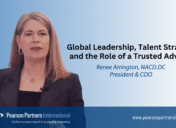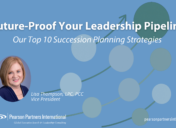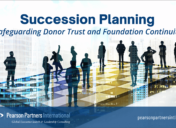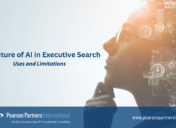How to Attract and Retain Top Talent at Not-For-Profit Organizations
Talent strategy at not-for-profit organizations has long been a challenging prospect. It takes an accomplished leadership team to craft a brand, culture and compensation package to attract and retain talented leaders amidst tight budgets, public scrutiny and fierce competition for talent. So, how do they do it? Together with our global partners at IIC Partners Executive Search Worldwide, we asked senior executives at leading not-for-profit organizations to share their challenges and successes.
Competing For Talent
How To Make Your Not-For-Profit The Top Choice For Candidates
Not-for-profit organizations need to build a complete 360 package matched with an exciting, mission-driven brand and culture and communicate this with clarity. Here are the key elements that our interviewees identified for attracting and retaining talented employees.
Compensation
Compensation is one area where it is hard to compete across the labor market—most of the leaders that we interviewed agreed they could not match commercial salaries. However, at higher positions, compensation can still be attractive and is not a barrier to entry for professionals with commercial backgrounds. Kathryn Allen, Regional Senior Vice President, American Heart Association, commented, “Once you get up in the upper ranks, I think our chief mission officer aligns with business officers. Both the actual pay and the benefits package are very, very rich.”
Jennifer Bartkowski, CEO, Girl Scouts of Northeast Texas, shared this belief and stressed that the industry needed to communicate better about the benefits of a long career in not-for-profit: “We are trying to find ways to better communicate the impact you can have in the nonprofit sector. You can earn a living wage in the nonprofit sector if you move up the chain of command. So there’s real opportunity there.”
“We are trying to find ways to better communicate the impact you can have in the nonprofit sector. You can earn a living wage in the nonprofit sector if you move up the chain of command. So, there’s real opportunity there.” – Jennifer Bartkowski, CEO, Girl Scouts of Northeast Texas
Offering competitive compensation packages within the not-for-profit industry is essential. Almost all not-for-profits we spoke with conduct compensation reviews to ensure staff and candidates are receiving market value for their work: “I hire a compensation firm to review our salaries every three years, and I try very hard to make sure that our salaries are competitive in the marketplace,” added Bartkowski.
This attitude underpins the ethical culture of many not-for-profit organizations, where they commit to living their values and ensure that staff are compensated well to the best of their ability.
In some functions such as highly educated clinical roles, however, there can be greater competition with commercial organizations as the gap between potential salary can be wider. Paige Flink, CEO, The Family Place, commented, “We are having a hard time. Our turnover was more this year at the entry-level because the market’s crazy and people can go and make a lot of money.” That is where the following elements come in.
Mission-Driven Candidates
Money is not usually the motivating factor for talent attracted to the not-for-profit sector. Many of the leaders we spoke with believed they do not compete with commercial organizations at all as candidates are driven by the mission: “I think people soft-select already, and they realize they’re making that trade-off versus our trying to compete. In the 15 years I’ve been in nonprofit, I’ve never had to compete with the for-profit people. They’ve already made that mind shift,” stated Stacey Malcomson, President and CEO, The Senior Source.
Jan Langbein, CEO, Genesis Women’s Shelter & Support, added, “It goes back to people who would like to make a difference. It’s somebody who says, ‘I want my day to matter’…You have to have a fire in your belly to end violence against women and children.”
 Interestingly, the majority of leaders at the not-for-profits we interviewed either came from commercial backgrounds or their colleagues did: “Almost all of my executive team have come from the corporate world or the academic world. They’re here for the mission, not for the pay necessarily, but we still have to pay them competitively,” stated Trisha Cunningham, CEO/President, North Texas Food Bank. It reinforces the idea that while salaries have to be attractive, they don’t have to match for-profits because candidates are purpose-driven.
Interestingly, the majority of leaders at the not-for-profits we interviewed either came from commercial backgrounds or their colleagues did: “Almost all of my executive team have come from the corporate world or the academic world. They’re here for the mission, not for the pay necessarily, but we still have to pay them competitively,” stated Trisha Cunningham, CEO/President, North Texas Food Bank. It reinforces the idea that while salaries have to be attractive, they don’t have to match for-profits because candidates are purpose-driven.
This does not come as a surprise, but it is an important point as the new generation of leaders are increasingly mission-driven. Not-for-profits should feel proud of their work and communicate it clearly during the hiring process.
PTO, Healthcare and Benefits
In our interviews, there was a strong emphasis on the full compensation package, not just salary: “Beyond our mission, we have focused on the business side of human resources. We have created a total benefits package to rival that of for-profit companies,” commented Scotty Landry, CEO, Make-A-Wish, North Texas.
One of the critical elements of this total package is a comprehensive healthcare offering: “The other thing that we’ve done that tends to be attractive and I’m not saying we are going to do this forever, is we pay 100 percent of the employee’s benefit costs. We want to make sure our employees have access to good healthcare,” stated Trisha Cunningham, CEO/President, North Texas Food Bank.
Another attractive element mentioned by many of our interviewees is more-than-standard paid time off: “[We offer] a really robust vacation package. You can start earning the minute you’re here.” stated Paige Flink, CEO, The Family Place.
“You need to communicate the entire compensation package very clearly—that it entails a good retirement package and health allowance and that we offer a modern, activity-based office landscape. The physical working environment is, of course, important.” – Ulrika Årehed Kågström, Secretary General, Cancerfonden
Along with a comprehensive benefits package, you need to know how to discuss it effectively with candidates, so the true value is understood: “You need to communicate the entire compensation package very clearly, that it entails a good retirement package, health allowance and that we offer a modern, activity-based office landscape. The physical working environment is, of course, important,” shared Ulrika Årehed Kågström, Secretary General, Cancerfonden.
A robust benefits package can help candidates remove any fears that their living standards will be reduced due to a lower-than-commercial salary—which is often not the case.
Self-Care and Wellness Support
Another trend we are seeing is an increase in support services around self-care and wellness, and these peripheral benefits can be very desirable to candidates.
“We build in self-care and that sort of thing as a benefit of being here. We bring in people to help take care of the caregivers,” stated Paige Flink, CEO, The Family Place.
The attraction for candidates is not the tangible value of these services, but instead, the impression of a compassionate and caring culture. All of the leaders we spoke with deeply cared about their employees’ health and living standards, and were great examples of living their ethical values.
Trisha Cunningham, CEO/President, North Texas Food Bank, added, “We switched healthcare providers last year, and we’ve learned a lot of the things that we could add to the ‘our wellness’ component. We just launched a fitness club pass so you don’t have to join only one club. You can go and attend a yoga class here, or a Zumba class here, a Pilates class here. It makes it an affordable option for some of our employees to get their fitness in, and we are helping to support self-care.”
Flexible Hours and Remote Working
In a more recent development, offering flexible hours and remote working has become a pivotal offering to attract and retain high-performance employees.
Scotty Landry, CEO of Make-A-Wish, North Texas, commented, “I cannot stress enough how important flexibility is for our team members and how interested job candidates are about it during our interview process. Many, many candidates explain how even if the pay isn’t the highest they are offered, the ability to flex their time makes up the difference.”
“I cannot stress enough how important flexibility is for our team members and how interested job candidates are about it during our interview process. Many, many candidates explain how even if the pay isn’t the highest they are offered, the ability to flex their time makes up the difference.” – Scotty Landry, CEO of Make-A-Wish, North Texas
Landry’s finding that candidates’ willingness to flex their salary requirements in exchange for flexible working at mission-driven organizations is becoming an increasing occurrence across the sector.
A Culture of Empowerment
Offering flexible hours and remote working is not just a tool to attract new employees; it is a core belief in empowerment that is often inherent to social impact organizations. Landry continued, “We recognize our employees are fully-formed adults and are capable of balancing their work responsibilities with life responsibilities. We know how much our employees give to our mission and we want them to feel valued. Our candidates are drawn to the intangibles you can’t put a price on.”
 Dale Cleaver, CEO, Guide Dogs NSW/ACT, added, “The chance to be part of an organization that is transforming itself, knowing that staff and leaders can affect and visualize their results quickly—that is sometimes not found in the private sector.” It is this attitude of fairness, empowerment and mission that makes working at nonprofits extremely rewarding.
Dale Cleaver, CEO, Guide Dogs NSW/ACT, added, “The chance to be part of an organization that is transforming itself, knowing that staff and leaders can affect and visualize their results quickly—that is sometimes not found in the private sector.” It is this attitude of fairness, empowerment and mission that makes working at nonprofits extremely rewarding.
All of our interviewees discussed the importance of carefully designing the organization’s culture with employees in mind: “First and foremost, it’s about what kind of organization and environment are we offering to them. We spend a lot of time on culture and developing a work environment that is attractive to everyone,” shared Jennifer Bartkowski, CEO, Girl Scouts of Northeast Texas.
Needing to craft your culture to meet evolving employee expectations is particularly true of younger generations—more on that later.
Professional Development and Training
Investing in professional development is attractive to many employees in today’s environment of lifelong learning: “We invest pretty significantly in our employees. We do manager one on one training whenever someone gets into that position. We do some professional coaching as well when it’s appropriate. We have a succession planning program where we are trying to develop skills in our employees,” stated Jennifer Bartkowski, CEO, Girl Scouts of Northeast Texas.
“We invest pretty significantly in our employees. We do manager one-on-one training whenever someone gets into that position. We do some professional coaching as well when it’s appropriate. We have a succession planning program where we are trying to develop skills in our employees.” – Jennifer Bartkowski, CEO, Girl Scouts of Northeast Texas
Even when a path to the top is not possible, a focus on development is still there: “Even if there’s not a lot of opportunity for organizational advancement, I can guarantee that we can make you the best in your field. We offer professional development, training and coaching, and these skills are not only applicable to developing the roles at Genesis, but they are transferrable to any career move an employee may decide to make in the future,” said Jan Langbein, CEO, Genesis Women’s Shelter & Support.
A similar approach is taken by Paige Flink, CEO, The Family Place, who is responding to greater specialization in clinical work with increased training: “Where you used to have a master’s level, now you have training in EMDR, which is a treatment modality that’s very specific and very expensive. If you don’t have that skill, we train you. Focusing on that kind of professional development is one thing we’re doing.”
Flink continued, “We also have an online learning management system that has a number of modules. If you are entry-level and you want to progress in management, for example, there are certain online classes that you have to take. We’re constantly trying to professionalize The Family Place at a higher and higher level.”
Volunteering
An interesting finding is that not-for-profit employees deeply value the opportunity to volunteer on the frontline: “Our employees’ ability to work with our Wish families and Wish kids is almost always rated number one when we ask employees what they like about their jobs. It is also one of the top reasons job candidates give when asked why they applied with Make-A-Wish—they love our mission and want to be a part of it,” shared Scotty Landry, CEO, Make-A-Wish, North Texas.
Stacey Malcomson, President and CEO, The Senior Source, shared this approach: “The incentives that we offer includes time off for volunteering. We try to have more flexible schedules.”
As did Jennifer Bartkowski, CEO, Girl Scouts of Northeast Texas: “We really embrace their opportunities to give back. We actually had a rule that you could not be a Girl Scout leader while you were working at Girl Scouts, and we’ve just changed that because we had enough young people come in and say ‘I want to get to do that too. I want to volunteer my time.’ So we’ve adjusted that.”
Clear from our research is that conversations with potential candidates have become far more nuanced and complex. The mission is important, but not enough on its own. Not-for-profit organizations are continually evaluating and adjusting their offering to remain competitive and attractive to the purpose-driven leaders who want to make a difference.
Next-Generation of Leadership
 Our interviewees believed that the next generation of leaders are uniquely attracted to not-for-profit work as they are purpose-driven: “Our team is made of up roughly 50% millennials. As studies have shown, being connected to a cause provides deep connection for millennials and drives engagement,” commented Scotty Landry, CEO, Make-A-Wish, North Texas.
Our interviewees believed that the next generation of leaders are uniquely attracted to not-for-profit work as they are purpose-driven: “Our team is made of up roughly 50% millennials. As studies have shown, being connected to a cause provides deep connection for millennials and drives engagement,” commented Scotty Landry, CEO, Make-A-Wish, North Texas.
Stacey Malcomson, President and CEO, The Senior Source, added, “I feel like the millennials really want to have that meaning in their work, and they’re willing to sacrifice pay for it. I think it’s kind of coming to us fortunately in that respect. I think people really want to help others.”
“I feel like the millennials really want to have that meaning in their work, and they’re willing to sacrifice pay for it. I think it’s kind of coming to us fortunately in that respect. I think people really want to help others.” – Stacey Malcomson, President and CEO, The Senior Source
Another great trait of younger generations, according to Alissar Barakat, Founder and President, DAR AL ALI Association, is their ability to manage constant change: “The Lebanese environment is never stable, however, due to its constant instability, the Lebanese next generation is self-trained on change management in all its aspects, and that easily reflects in their work with us.”
Building a pipeline of talent to fill entry-level positions and progress right up to the C-suite is an essential component of not-for-profit talent strategy. Of the elements to successfully attract new employees, which are particularly crucial for the next generation of leaders?
Inclusive Organization Design
The number one message we received from our research was that the entire organization—brand, processes, policies and values—must be designed with your target employees in mind. This user-led design process pays dividends according to Dale Cleaver, CEO, Guide Dogs NSW/ACT: “Our brand is currently being redeveloped to make it more contemporary and attractive to younger demographics including employees.”
And these efforts are not surface-deep: “Our organizational values were recently co-designed with staff, including younger employees and we are working on our culture generally to move it away from a hierarchical and formal style,” continued Cleaver.
Trisha Cunningham, CEO/President, North Texas Food Bank, also stressed the importance of shaping your culture to fit the changing motivations of the new generation of leadership: “Over the past 18 months we have really been pushing an empowered culture versus a directive culture because we know that a lot of the younger employees want to change the world. They don’t want to come in and have someone tell them this is what I want you to do. They want their ideas to be heard as well. We have been bringing in this culture of empowerment, and we actually had a 20 percent increase from our last employee engagement survey to this employee engagement survey in the fact that the employees feel empowered, which is fantastic.”
Flexible Working and Tailored Benefits Packages
While flexible hours and remote working are desirable for all generations, it is an “attractive benefit particularly to young people,” stated Jennifer Bartkowski, CEO, Girl Scouts of Northeast Texas. Offering flexibility in work delivery can open your search to a broader range of candidates. This is particularly true for people who are disabled or chronically ill.
It is also essential to recognize the specific needs of younger audiences and where extra assistance should be given: “We also find that many younger employees don’t understand why they should invest in a retirement plan. We contribute to the employee’s retirement plan without even a match, up to five percent a year, which is also an incredible benefit. We’re bringing in additional resources to be able to help our employees increase their financial knowledge and how they need to manage their personal finances as well,” stated Trisha Cunningham, CEO/President, North Texas Food Bank.
Leadership Programs
 Another key strategy to attract new young leaders is to offer beneficiaries, volunteers, and entry-level employees a chance to become managers through leadership programs: “We have what we’re calling a Leadership Institute. We select ten people from across the food bank and we will bring people in on a monthly basis and they talk to them. The participants are hand-selected as high potential employees that need additional leadership training. We tie everything that we do to the mission, but we also let them know that through this Leadership Institute, we’re investing in them,” said Cunningham.
Another key strategy to attract new young leaders is to offer beneficiaries, volunteers, and entry-level employees a chance to become managers through leadership programs: “We have what we’re calling a Leadership Institute. We select ten people from across the food bank and we will bring people in on a monthly basis and they talk to them. The participants are hand-selected as high potential employees that need additional leadership training. We tie everything that we do to the mission, but we also let them know that through this Leadership Institute, we’re investing in them,” said Cunningham.
Alissar Barakat, Founder and President, DAR AL ALI Association, uses community work with young beneficiaries to identify new leaders: “This exposure also allows us to identify young promising leaders and help them exercise their leadership skills by engaging them with various teams to achieve common goals that benefit the society they live in.”
Ulrika Årehed Kågström, Secretary General, Cancerfonden, saw a huge benefit from this approach at her previous role as Secretary General at Red Cross: “We don’t have any youth organization [at Cancerfonden] where you get young talent interested in the organization and then directed to the mother company such as the Red Cross, that is one of their advantages.”
Training
Both The Family Place and Genesis Women’s Shelter & Support attract younger staff through training and development programs that offer staff a logical next step to build clinical experience. However, retention can be tough—after being fully trained, many move into private practice: “At Genesis, we don’t struggle to attract the younger generation. Our focus is more on whether the candidates display emotional maturity, drive and passion,” shared Jan Langbein, CEO, Genesis Women’s Shelter & Support.
Flexible Job Requirements
Increasingly employers across all sectors are focusing more on potential, not on formal experience. This is especially true for not-for-profits hiring for non-clinical roles. Ulrika Årehed Kågström, Secretary General, Cancerfonden, went as far as completely redesigning their management structure: “We have decided to redirect our focus to the potential among younger candidates rather than placing too much emphasis on formal requirements. The demands we put on managers were unrealistic. Instead, we are focusing on creating more managerial levels, a sort of entry-level leading positions.”
Recruitment Processes
Along with a comprehensive package, a strong brand and a values-driven culture, not-for-profits are successful at attracting and retaining talented leaders by evaluating and changing their recruitment processes.
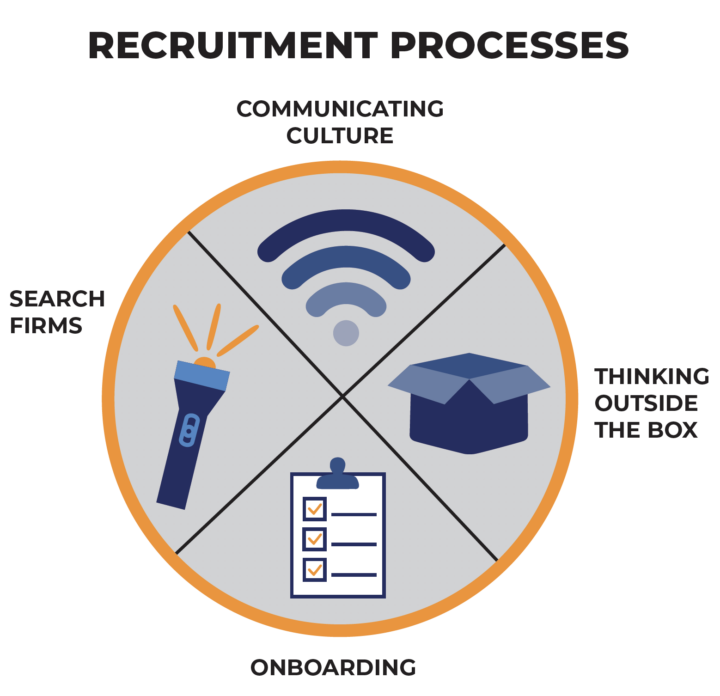
Onboarding is Crucial
There can be a risk of culture shock for any new hire, but this can be heightened for executives transitioning from for-profit organizations. Several respondents commented on the critical importance of a well-developed onboarding strategy to mitigate risks: “When hiring new co-workers, from outside our sector in particular, we put a bigger focus on their onboarding process until they get used to their new working environment and our culture. There is a value in that process that can’t be measured in monetary terms,” stated Ulrika Årehed Kågström, Secretary General, Cancerfonden.
Use a Search Firm
 All of our respondents have utilized executive search firms to meet their growing talent needs. Jan Langbein, CEO, Genesis Women’s Shelter & Support, commented on one search that went particularly well as a result: “I needed the technical help for hiring a major gift officer. By working with an executive search firm, I hit the jackpot of all jackpots! Not only does she care about the issue, but she has a specialized background, is a cultural fit and has been setting and exceeding measurable goals.”
All of our respondents have utilized executive search firms to meet their growing talent needs. Jan Langbein, CEO, Genesis Women’s Shelter & Support, commented on one search that went particularly well as a result: “I needed the technical help for hiring a major gift officer. By working with an executive search firm, I hit the jackpot of all jackpots! Not only does she care about the issue, but she has a specialized background, is a cultural fit and has been setting and exceeding measurable goals.”
Some not-for-profit leaders can encounter resistance to using search firms, perhaps a result of restricted budgets or a grassroots approach to hiring. Kathryn Allen, Regional Senior Vice President, American Heart Association, thinks this is a mistake: “You’re short changing yourself.” Investing upfront can mitigate a lot of hiring risks and help you access a more extensive network of talented professionals.
Communicating Culture
Having a great brand and culture is essential, but without a smart communications strategy, it can exist in a vacuum. Our interviewees prioritized making their employees feel happy, engaged and included, and then they encouraged them to share their experience publicly: “It was once said that “Make-A-Wish is the Southwest Airlines of the nonprofit world.” We love that analogy. We strive for a culture that is fun. A place that everyone enjoys coming to work. One where employees like using the hashtag of #bestjobever in their social media post. We don’t always achieve this level with every employee, but we try,” commented Scotty Landry, CEO, Make-A-Wish, North Texas.
“We strive for a culture that is fun—a place where everyone enjoys coming to work. One where employees like using the hashtag of #bestjobever in their social media posts. We don’t always achieve this level with every employee, but we try.” – Scotty Landry, CEO, Make-A-Wish, North Texas
Paige Flink, CEO, The Family Place, links this sharing on social media directly to their hiring strategy: “We post fun things we do at The Family Place or try to do more interesting posts as opposed to just job postings.”
In relation to hiring social workers, Barakat noticed a trend of greater interest in not-for-profits that have assisted their efforts: “Recently, most of the social workers are following up closely on the performance of humanitarian NGOs in the country, and we promote our work by posting our achievements on social media.”
In the past, there was a lot of emphasis on candidates needing a positive online presence. Today that also applies to organizations. Candidates are increasingly using social media as a window into the organization and want as much insight as possible into what their employee experience may be.
Think Outside the Box
The final stand out hiring trend from our research is a willingness to look beyond traditional entry routes or backgrounds: “We’re not looking for particular fundraisers as much as we are people who are interested in sales. I think that nonprofits have to look at what are the transferable skills and what are the similar industries,” stated Kathryn Allen, Regional Senior Vice President, American Heart Association.

Diversity
While all organizations are under increasing public scrutiny to diversify their leadership, the pressure is amplified for not-for-profits who are often held to higher standards than commercial organizations.
A challenge unique to the not-for-profit industry is the need to attract more men into roles across the organization: “We pay attention to diversity, whether it’s hiring more men or trying to hire leaders that represent diversity. We’re highly conscious of it, but we’re also pretty successful at it,” stated Paige Flink, CEO, The Family Place.
Stacey Malcomson, President and CEO, The Senior Source, added that when it came to diversity, she was “more concerned about adding men,” demonstrating the extremity of the issue.
Across the sector, however, there is still a way to go with gender equality at the top, with women still falling behind at the CEO and Board level. This issue of lower representation of women at the top extends to all areas of diversity. Malcomson continued, “Our younger staff are very diverse, but at our director level, it is not as diverse.” So what can leaders do to encourage greater diversity and inclusion?
Flexible Job Requirements
Jan Langbein, CEO, Genesis Women’s Shelter & Support, highlighted that formal education requirements are a barrier to hiring diverse candidates: “We find that graduate schools are just not full of diversity for that functional area. We hire masters level candidates, which can be difficult to do.”
Ulrika Årehed Kågström, Secretary General, Cancerfonden, experienced the same issue: “We are not as successful at recruiting individuals from areas lacking socioeconomic strength, due to the high requirements on former experience, something we are trying to change now.”
However, according to Paige Flink, CEO, The Family Place, recently these barriers are coming down: “The diversity of our population in Texas is changing, and education is more accessible to diverse people.” Still, remaining flexible in job requirements and offering training towards formal qualifications is a vital strategy for attracting a diverse workforce.
Prepare for the Long-Haul
Implementing strategies to support diverse hiring can encounter resistance from already stretched not-for-profit employees, according to Ulrika Årehed Kågström, Secretary General, Cancerfonden: “The recruiting managers have struggled with balancing their need to recruit someone quickly with meeting our need to challenge the profile and find different talent. It has been the HR department and me as Secretary General who have had to stand up and argue for this recruitment strategy and try to coach the resistance we have met from the managers.” Despite the difficulty, Kågström believes the rewards soon become evident: “As we have worked with this new strategy for some time now, the resistance is less and less as the managers see the results, the people we have been able to recruit now and what they add to the organization.”
“The recruiting managers have struggled with balancing their need to recruit someone quickly with meeting our need to challenge the profile and find different talent.” – Ulrika Årehed Kågström, Secretary General, Cancerfonden
Hire Search Firms to Expand Reach
As discussed above, hiring diverse candidates can be a complex process after decades of exclusionary practices—but a search firm can help: “The organization has to be intentional in a commitment to diversity and younger folks. And then they have to get the resources, like hiring a search firm to go find it,” commented Kathryn Allen, Regional Senior Vice President, American Heart Association.
In summary, here are the top things to keep in mind when attempting to diversify your organization:
-
- Flex formal requirements. Hire for potential, not just experience.
- Prepare for the long-haul. Hiring for diverse talent can require some significant changes, but the dividends soon come.
- Extend your reach with search firms. Search firms are a vital extension of your HR team to help you expand access to diverse talent.
Performance Management
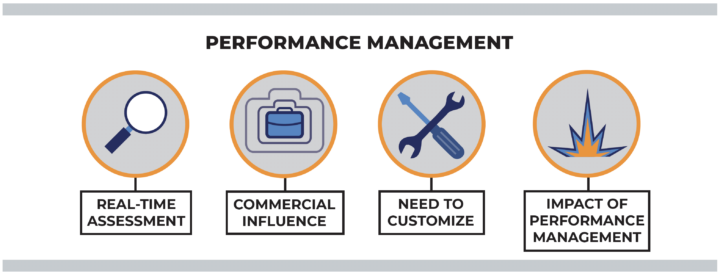
Performance management at not-for-profit organizations operates at extremely high stakes. Work output can be critical to the lives of millions, and external funders have strict performance requirements: “I think a lot of people misunderstand nonprofit organizations and think that we aren’t businesses or that we don’t have a formal structure in place. So we work very hard at being a 21st-century business, which means we have to have performance standards,” stated Jennifer Bartkowski, CEO, Girl Scouts of Northeast Texas.
Productivity is often closely monitored, ensuring funding targets and impact goals are met: “Measuring productivity is another thing that we’ve really instituted. We’ve got an online client tracking system now where we can see real-time how many clients you’re seeing on a weekly basis, and there’s an accountability to that,” stated Flink.
“Measuring productivity is another thing that we’ve really instituted. We’ve got an online client tracking system now where we can see real-time how many clients you’re seeing on a weekly basis, and there’s an accountability to that.” – Paige Flink, CEO, The Family Place
In line with the values of empowerment, this tracking is not about controlling employees, but more about ensuring they reach as many people who need their services as possible. Not-for-profits often have long waitlists or coverage gaps due to funding shortfalls. One solution is to raise more money; another is to maximize performance.
Real-Time Assessment
 Ongoing, real-time assessment is essential to achieving the most performance gains: “Our performance evaluation system is a continuous rather than periodic process,” stated Alissar Barakat, Founder and President, DAR AL ALI Association.
Ongoing, real-time assessment is essential to achieving the most performance gains: “Our performance evaluation system is a continuous rather than periodic process,” stated Alissar Barakat, Founder and President, DAR AL ALI Association.
Scotty Landry, CEO, Make-A-Wish, North Texas, added, “The greatest value to our business comes from our ability to make quick course corrections during the year because our managers and team members evaluate big picture goals and progress regularly instead of only once a year.”
This approach includes daily reporting in the American Heart Association fundraising team: “The individual sends a daily report on where they are compared to their goal,” stated Kathryn Allen, Regional Senior Vice President, American Heart Association. The myth that not-for-profits have fewer performance management requirements than commercial organizations is clearly false.
Commercial Influence
All of the interviewees closely modeled their performance management systems from those used at commercial organizations—this is not surprising when many not-for-profit leaders have commercial backgrounds.
Sometimes this includes financial incentives tied to performance: “If you feel like you are getting differentiated pay for your performance, then it’s definitely a motivator for you to continue to excel in what you’re trying to do. One size does not fit all—and we all know that from the corporate background and structure you get differentiated pay,” shared Trisha Cunningham, CEO/President, North Texas Food Bank.
Kathryn Allen, Regional Senior Vice President, American Heart Association, added, “[Fundraisers] can get up to 25 percent of their salary in incentives. I do feel like we have modeled ourselves after more of the private sector than other nonprofits.”
Yet, according to Barakat, there is a crucial difference: “Although our performance evaluation system is somehow similar to the private sector, the bottom line of our mission is different, and that makes a big difference because the private sector focuses on profit and gain, while our mission is a better life and well-being of people—which includes no profit and where ethics, goodwill and values play a major role in the staff performance.”
Including ethical behavior in performance reviews is a key differentiator that is increasingly being adopted by commercial organizations as they face greater public scrutiny.
The Need to Customize
While there is influence from other sectors or past experience, it is vital to customize the platform to your specific needs: “We work with consulting teams and external partners but always make sure that we own the system ourselves. Otherwise, it is hard to establish ownership of the system and if it won’t be used, we need to take responsibility for it and feel it is ours,” stated Ulrika Årehed Kågström, Secretary General, Cancerfonden
Sometimes this includes extending it beyond traditional uses: “We took that instrument and rolled it back to the interview process. My interview process is several steps, and one of the steps is this panel interview where we are trying to predict the probability of success at the end of the year. The instrument we use in the interview process is taken from the annual assessment,” stated Stacey Malcomson, President and CEO, The Senior Source.
The Impact of Performance Management
Successful performance management systems lead to greater accountability and data-driven action: “We act now on performance issues much faster than we ever have in the past because one of our values is accountability and if you’re not performing, we have to take action on that,” stated Jennifer Bartkowski, CEO, Girl Scouts of Northeast Texas.
Scotty Landry, Make-A-Wish, North Texas, added, “We used to have a very complicated performance management system that wasted our managers’ time and team members were not involved in the process. The GPS system (growth/plan/support), which is developed by our leadership team and was based on private-sector systems, has improved our team’s performance by ensuring clear expectations are set and monitored throughout the year.”
However, if the system is not working, it can derail an organization—like when Jennifer Bartkowski, CEO, Girl Scouts of Northeast Texas experienced widespread issues with a new customer engagement initiative: “I went to the board after we implemented it and said, look, we’ve broken our system here. We’ve broken the organization and we’re going to have to rebuild.” Bartkowski used this breakdown as a chance to demonstrate tough leadership and not being afraid of challenges or failure: “It was kind of a blessing because it would have been harder to make change if we hadn’t broken it through that. And also, we have a nice reputation for doing hard things.” It is this kind of leadership that encourages employees to test, fail, learn and innovate.
Public Scrutiny
There is a rise of public scrutiny across all sectors as unethical behavior is increasingly exposed, and consumers make values-driven buying decisions. But this environment is not new to not-for-profits: “We feel like we’ve always been under scrutiny. I don’t feel different now because we’ve always had an accountability structure in our organization. We’ve always been audited by both our government funders and third-party auditors,” shared Paige Flink, CEO, The Family Place.
“I think our vendors are what holds us accountable. We’ve got a lot of government funding, so that helps us. We’re very metrics-based and have lots of ways to count. A lot of our funding comes from private and public grants, so we have to be on our toes all the time. And it’s something we pride ourselves on. Otherwise, people are not going to fund you. They want to know the outcome.” – Stacey Malcomson, President and CEO, The Senior Source
Also, funders have strict rules that keep not-for-profits accountable, and the penalties for missing targets can mean losing funding altogether: “I think our vendors are what holds us accountable. We’ve got a lot of government funding, so that helps us. We’re very metrics-based and have lots of ways to count. A lot of our funding comes from private and public grants, so we have to be on our toes all the time. And it’s something we pride ourselves on. Otherwise, people are not going to fund you. They want to know the outcome,” stated Stacey Malcomson, President and CEO, The Senior Source.
While it is positive to be results-driven and accountable, Ulrika Årehed Kågström, Secretary General, Cancerfonden, highlighted that too much caution could paralyze innovation and performance: “There is a strong fear of not doing right/doing the wrong thing, which hampers the development and creates a focus on details.”
This pressure to ‘do the right thing’ was also mentioned by Trisha Cunningham, CEO/President, North Texas Food Bank: “We’re a very prominent organization. Our brand study shows that we have the top awareness, so we want to make sure that we do not risk this and do things right.”
With increasing pressure to stand on issues, being too risk-averse can lead to missed opportunities to build brand awareness and advocate for your beneficiaries. But there is no denying that public scrutiny is fiercer than ever, so we truly understand the need to tread carefully.
Closing Comments
Attracting, developing and retaining talent at not-for-profit organizations is an increasingly complex prospect. Leading organizations are continually evolving their approach, and at the heart of their success is a deep commitment to employee empowerment and inclusive organization design.
Despite the challenges ahead, all of the developments we uncovered are extremely positive for the employee experience and for maximizing service delivery to those who need it most. We honor the incredible work of the leaders who are driving the not-for-profit sector forward.


